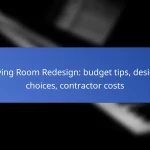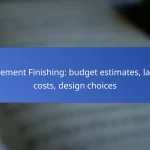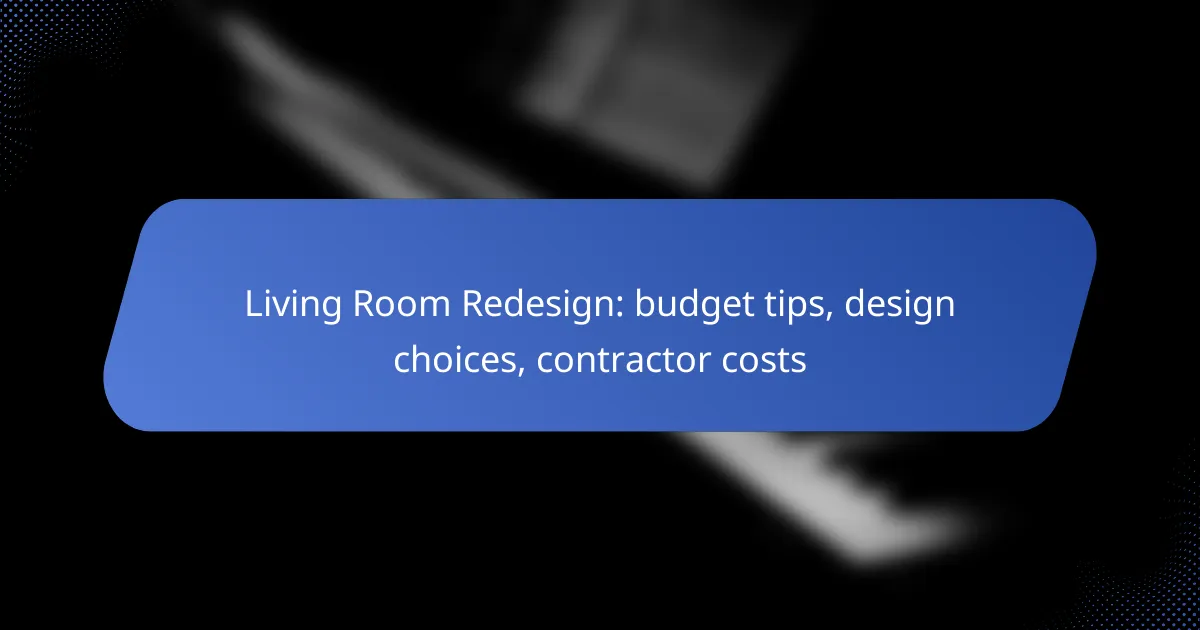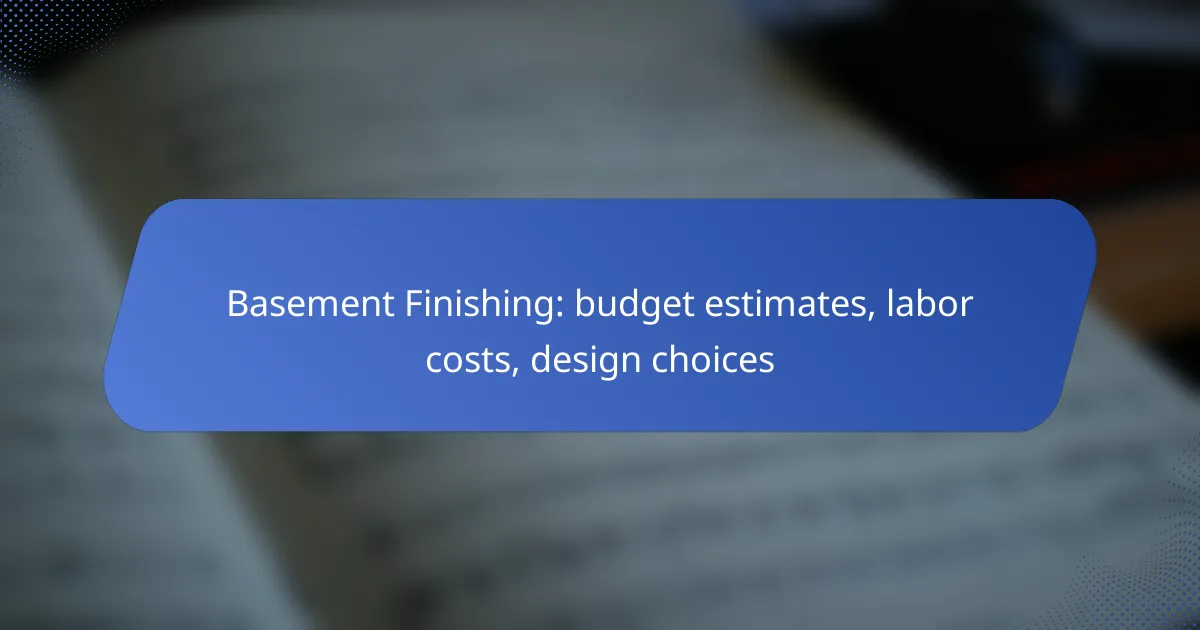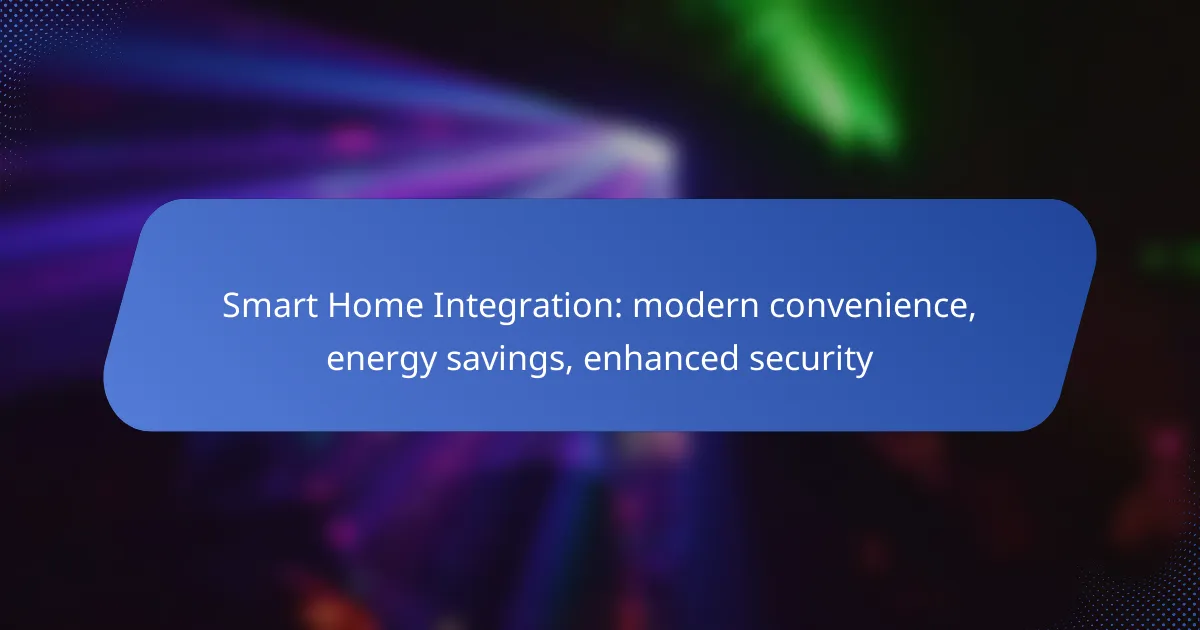Energy-efficient upgrades are essential for enhancing a home’s efficiency, lowering energy bills, and minimizing environmental impact. While the initial investment may appear daunting, the long-term savings often justify the costs, making these upgrades a financially sound choice. Various financing options are available to ease the upfront burden, allowing homeowners to invest in sustainable improvements that yield significant energy savings over time.

What are the energy-efficient upgrade options in the UK?
Energy-efficient upgrades in the UK include various options that enhance a home’s efficiency, reduce energy bills, and lower carbon footprints. Key upgrades focus on insulation, windows, heating systems, smart technology, and renewable energy sources.
Insulation improvements
Insulation improvements are essential for maintaining a comfortable indoor temperature while minimizing energy consumption. Upgrading insulation in walls, roofs, and floors can significantly reduce heat loss, leading to lower heating costs.
Consider materials like mineral wool, foam board, or spray foam, which offer varying R-values and installation methods. The UK government often provides grants or incentives for insulation upgrades, making them more affordable.
Energy-efficient windows
Energy-efficient windows help to prevent heat loss and improve overall home comfort. Double or triple glazing, low-E coatings, and argon gas fills are common features that enhance window performance.
When selecting windows, look for those with a good energy rating, typically labeled A to G, with A being the most efficient. Investing in quality windows can lead to significant savings on heating bills over time.
Smart thermostats
Smart thermostats optimize heating schedules and improve energy management in homes. They learn user preferences and adjust temperatures automatically, ensuring efficient energy use without sacrificing comfort.
Many smart thermostats can be controlled remotely via smartphone apps, allowing for adjustments even when away from home. This technology can lead to savings of around 10-20% on heating costs.
Solar panel installations
Solar panel installations harness renewable energy from the sun, reducing reliance on traditional energy sources. By converting sunlight into electricity, homeowners can significantly lower their energy bills and even sell excess energy back to the grid.
In the UK, the Feed-in Tariff scheme has been replaced by the Smart Export Guarantee, which compensates homeowners for surplus energy. Initial costs can be high, but government incentives and long-term savings make solar panels a worthwhile investment.
High-efficiency heating systems
High-efficiency heating systems, such as condensing boilers or heat pumps, provide effective heating while consuming less energy. These systems are designed to maximize energy use and minimize waste, resulting in lower utility bills.
When upgrading, consider the Energy Saving Trust’s guidelines for selecting the right system for your home. Although the upfront cost may be higher, the long-term savings and potential government grants can offset the initial investment.
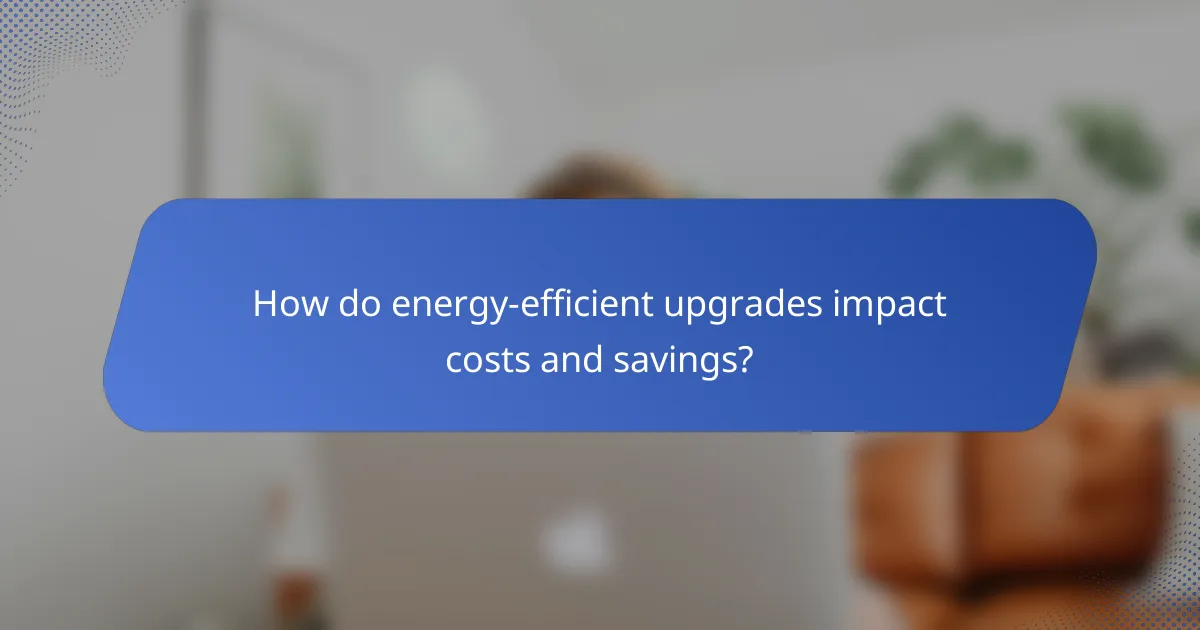
How do energy-efficient upgrades impact costs and savings?
Energy-efficient upgrades can significantly reduce both upfront costs and long-term savings on utility bills. While the initial investment may seem high, the cumulative savings over time often outweigh these costs, making such upgrades financially beneficial.
Initial investment vs. long-term savings
The initial investment for energy-efficient upgrades can vary widely depending on the type of improvement. For instance, upgrading insulation or installing energy-efficient windows may require a larger upfront cost but can lead to substantial savings on heating and cooling bills over the years.
Homeowners should consider the payback period, which is the time it takes for savings to equal the initial investment. Generally, a payback period of 5 to 10 years is considered reasonable for many upgrades, after which the savings contribute directly to profit.
Average ROI for common upgrades
The return on investment (ROI) for energy-efficient upgrades typically ranges from 10% to 30%, depending on the specific improvement. For example, installing energy-efficient appliances can yield a higher ROI compared to simple weatherization measures.
Some upgrades, like solar panels, may offer even higher returns, especially in regions with favorable incentives or rebates. Homeowners should research local programs that can enhance ROI through financial incentives.
Utility bill reductions
Energy-efficient upgrades can lead to noticeable reductions in utility bills, often ranging from 20% to 50%. For example, switching to LED lighting or upgrading to a high-efficiency HVAC system can significantly lower monthly energy costs.
Tracking utility bills before and after upgrades can help homeowners quantify their savings. Additionally, many utility companies offer programs to assist with energy audits, which can identify the most effective upgrades for further savings.
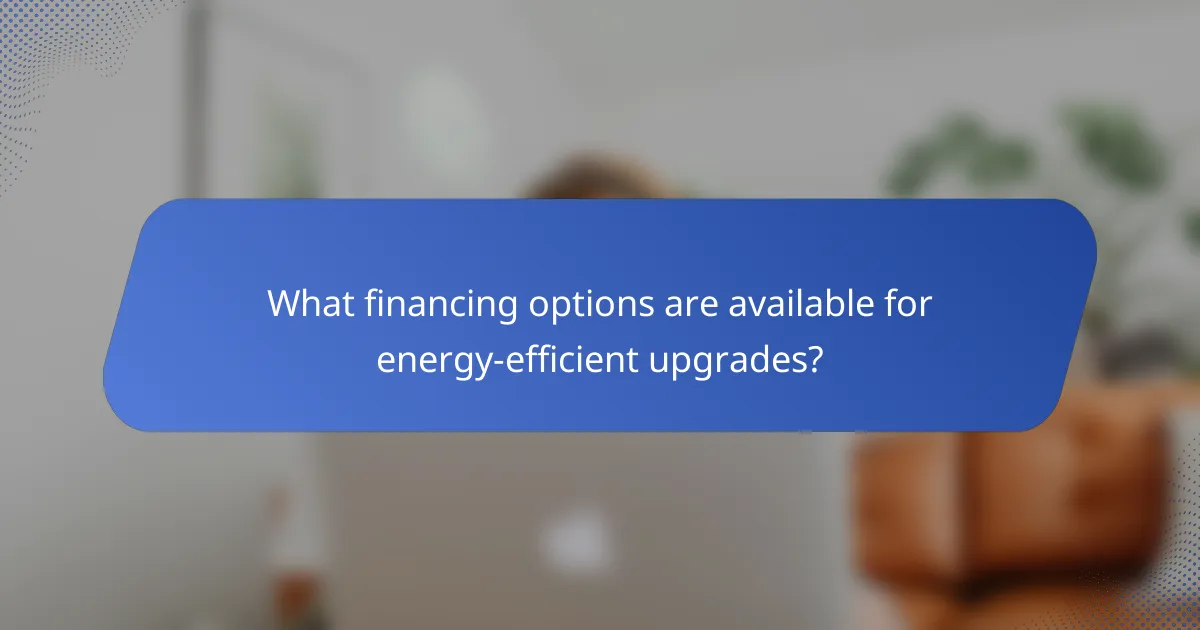
What financing options are available for energy-efficient upgrades?
Several financing options exist for energy-efficient upgrades, making it easier for homeowners and businesses to invest in sustainable improvements. These options can significantly reduce upfront costs while enhancing overall energy savings.
Government grants and incentives
Government grants and incentives are financial aids provided by federal, state, or local governments to encourage energy-efficient upgrades. These funds can cover a substantial portion of the project costs, often requiring no repayment.
Eligibility for these grants typically depends on the type of upgrade, the applicant’s income level, and the specific program guidelines. For example, programs like the Federal Investment Tax Credit (ITC) allow homeowners to deduct a percentage of the cost of solar systems from their federal taxes.
Low-interest loans
Low-interest loans are another viable financing option for energy-efficient upgrades, allowing homeowners to borrow money at reduced interest rates. These loans can be obtained from various sources, including banks, credit unions, and specialized lenders focused on green financing.
When considering a low-interest loan, it’s essential to compare terms and conditions. Look for loans with favorable repayment periods and minimal fees. Some programs may even offer deferred payments until the upgrades generate energy savings.
Energy company financing programs
Many energy companies offer financing programs to promote energy-efficient upgrades among their customers. These programs often include rebates, on-bill financing, or special loan terms that make it easier to afford improvements.
For instance, some utilities may allow customers to pay for upgrades through their monthly energy bills, spreading the cost over time. It’s advisable to check with local energy providers for specific offerings, as these programs can vary widely by region and may include additional incentives for energy-saving measures.
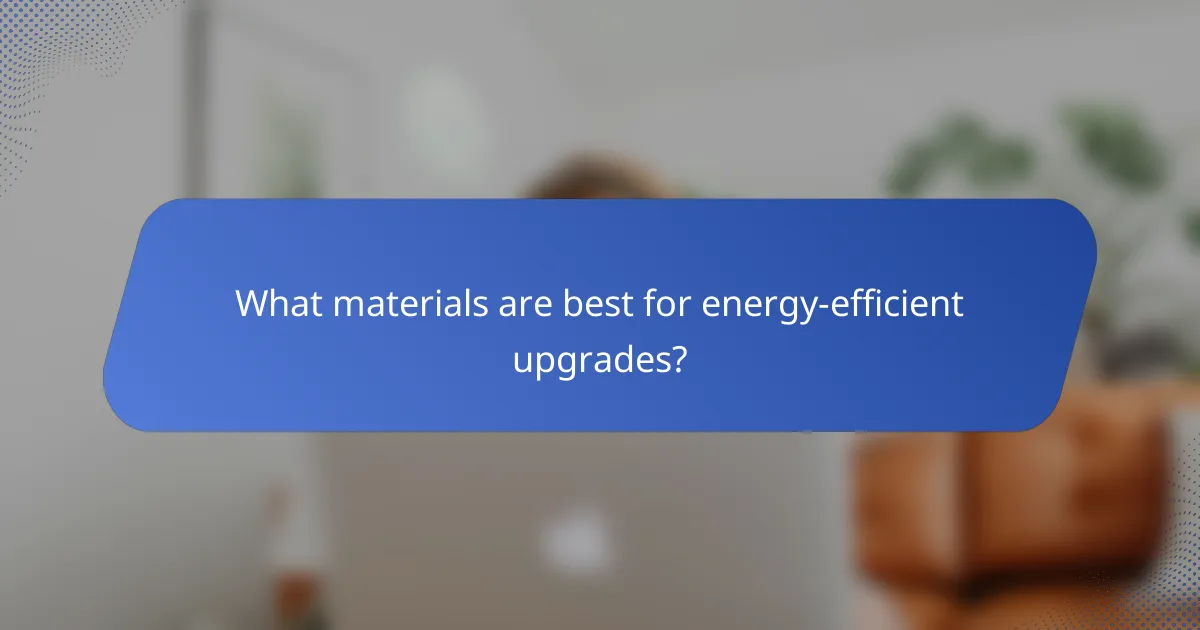
What materials are best for energy-efficient upgrades?
Choosing the right materials for energy-efficient upgrades can significantly impact both energy savings and costs. Key considerations include insulation, windows, and roofing, which all play crucial roles in enhancing a building’s energy performance.
Eco-friendly insulation materials
Eco-friendly insulation materials are essential for reducing heat loss and improving energy efficiency. Options such as cellulose, made from recycled paper, and sheep’s wool, which is natural and biodegradable, are popular choices. These materials not only provide excellent thermal resistance but also minimize environmental impact.
When selecting insulation, consider the R-value, which indicates thermal resistance. Higher R-values mean better insulation performance. For most climates, aim for R-values between 30 and 60 for attics and 13 to 21 for walls.
Double-glazed window options
Double-glazed windows consist of two panes of glass with a space in between, providing better insulation than single-pane windows. They reduce heat transfer, keeping homes warmer in winter and cooler in summer. Look for windows with low-emissivity (low-E) coatings, which reflect heat while allowing light to enter.
When choosing double-glazed windows, consider the U-value, which measures heat transfer. A lower U-value indicates better insulation. For optimal performance, aim for U-values below 1.6 W/m²K for residential windows.
Energy-efficient roofing materials
Energy-efficient roofing materials can significantly lower cooling costs and improve overall energy efficiency. Options like cool roofs, which reflect more sunlight and absorb less heat, are ideal for warmer climates. Materials such as metal, clay tiles, and certain types of shingles can enhance energy performance.
When selecting roofing, consider the Solar Reflectance Index (SRI). Higher SRI values indicate better reflective properties. For hot climates, choose roofing materials with an SRI of at least 0.3 to effectively reduce heat absorption.
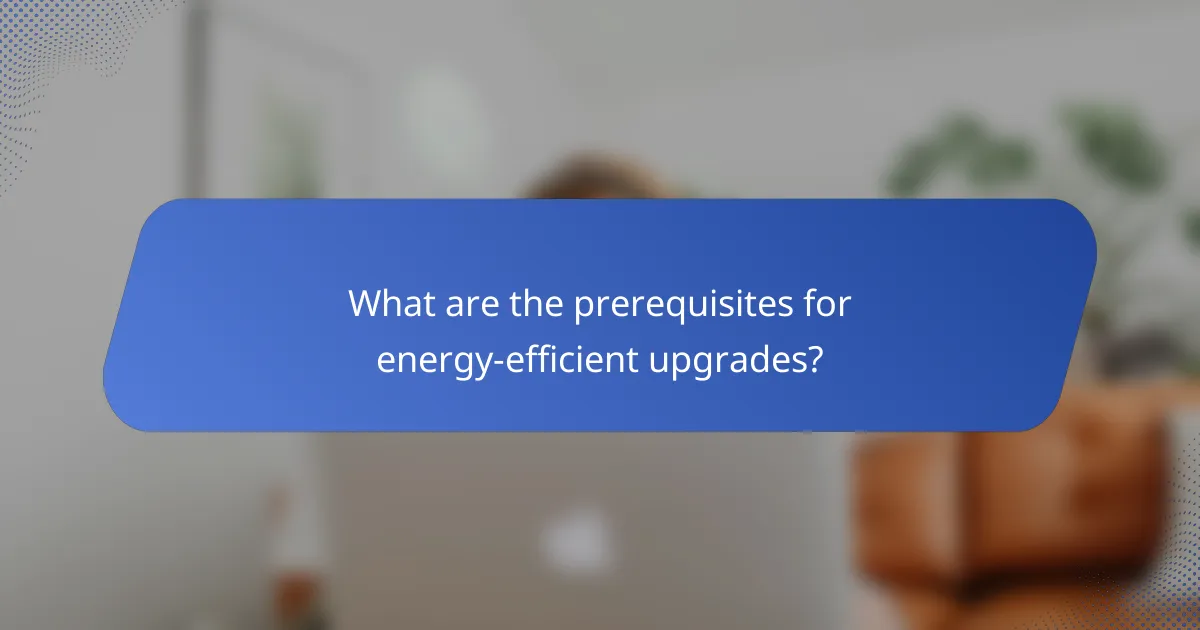
What are the prerequisites for energy-efficient upgrades?
Before undertaking energy-efficient upgrades, homeowners should assess their current energy use and ensure compliance with local building regulations. Understanding these prerequisites helps in making informed decisions that maximize both savings and efficiency.
Home energy audits
A home energy audit is a critical first step in identifying areas where energy-efficient upgrades can be made. This assessment typically involves a thorough examination of insulation, heating and cooling systems, and windows to pinpoint energy loss. Homeowners can expect to pay a few hundred dollars for a professional audit, but the insights gained can lead to significant savings.
DIY audits are also an option, where homeowners can check for drafts, inspect insulation levels, and evaluate appliance efficiency. However, professional audits often provide more comprehensive data, including blower door tests and thermal imaging, which can reveal hidden issues.
Building regulations compliance
Compliance with local building regulations is essential when planning energy-efficient upgrades. These regulations often dictate minimum efficiency standards for new installations, such as HVAC systems, insulation, and windows. Failing to adhere to these codes can result in costly fines or the need to redo work.
Homeowners should consult local building authorities or a qualified contractor to understand the specific regulations in their area. This ensures that all upgrades not only improve energy efficiency but also meet safety and legal standards, ultimately protecting the investment made in the home.
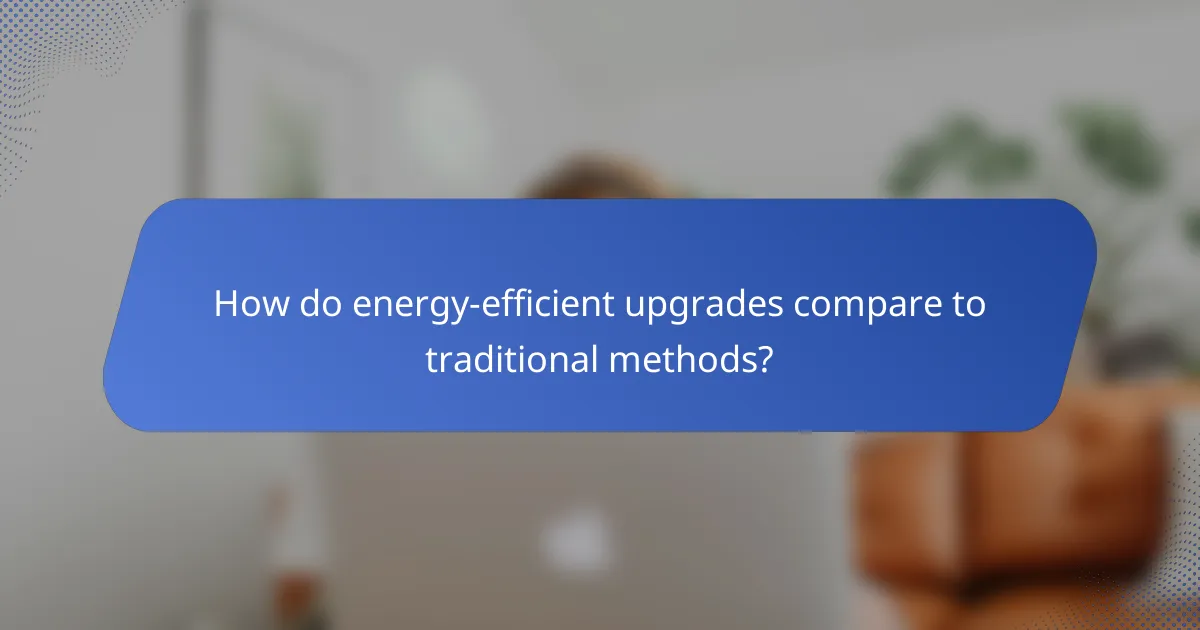
How do energy-efficient upgrades compare to traditional methods?
Energy-efficient upgrades generally offer significant long-term savings compared to traditional methods, despite potentially higher upfront costs. These upgrades often lead to reduced energy consumption, lower utility bills, and a smaller environmental footprint.
Cost-effectiveness analysis
When evaluating cost-effectiveness, consider both initial investment and long-term savings. Energy-efficient upgrades may have higher upfront costs, typically ranging from hundreds to thousands of dollars, depending on the project. However, the return on investment can be substantial, with savings on energy bills often covering the initial costs within a few years.
For instance, upgrading to energy-efficient windows can reduce heating and cooling costs by 10-25%. Additionally, many governments offer incentives, such as tax credits or rebates, which can further offset the initial expenses, making these upgrades more financially viable.
Performance metrics
Performance metrics for energy-efficient upgrades include energy savings, payback period, and environmental impact. Energy savings can be quantified in terms of kilowatt-hours (kWh) or therms, while the payback period is the time it takes for savings to equal the initial investment, often ranging from 3 to 10 years.
To assess environmental impact, consider metrics like carbon footprint reduction and compliance with local energy efficiency standards. For example, appliances with the ENERGY STAR label are recognized for their superior efficiency, often using 10-50% less energy than standard models. Evaluating these metrics helps homeowners and businesses make informed decisions about their energy-efficient upgrades.
